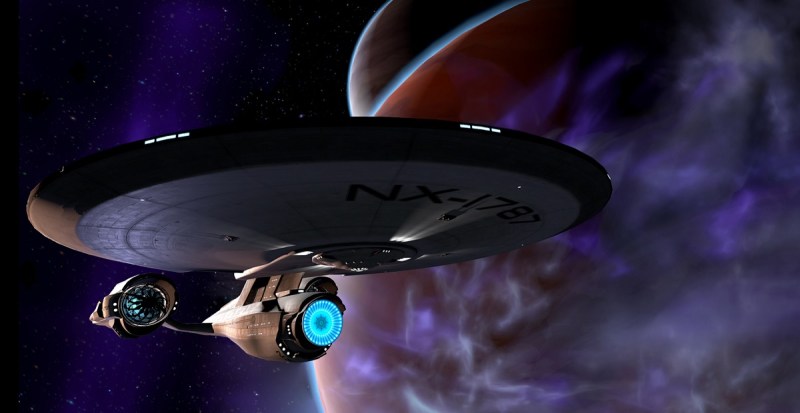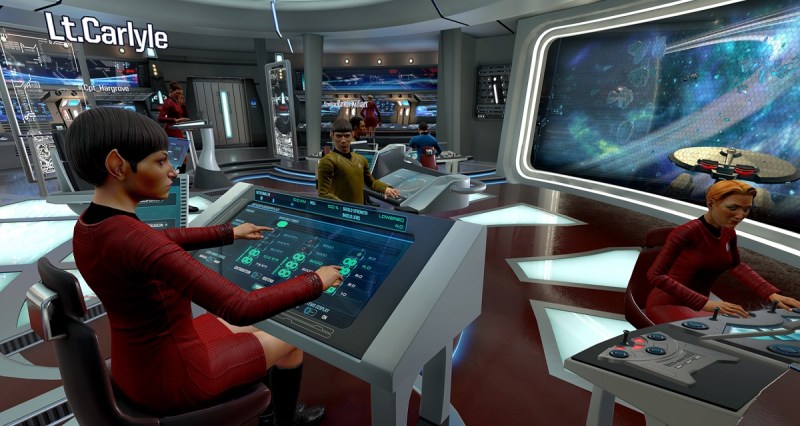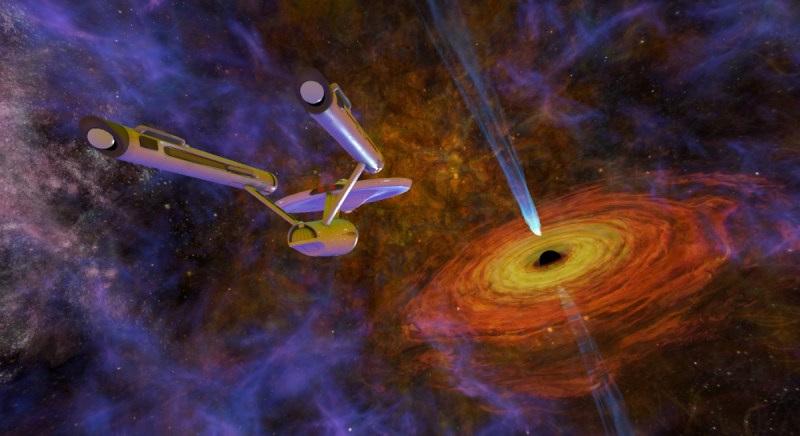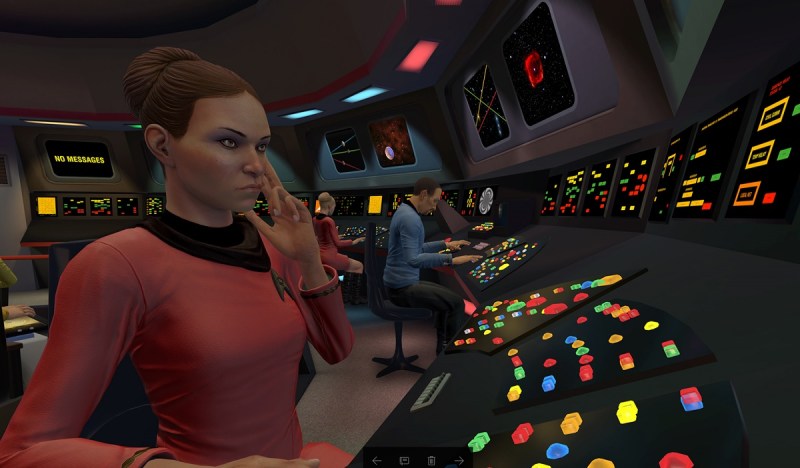Some say that virtual reality is going to be the most social medium ever, and that’s the feeling I got from playing a demo of Star Trek: Bridge Crew, the new virtual reality game coming from Ubisoft and its Red Storm studio.
In a four-player preview of a couple of missions, I had a hoot playing with my fellow game journalists during a preview event at Ubisoft in San Francisco. This game is built in a way that makes it easy for you to immerse yourself in the role of being a Star Trek bridge crew member. You’ll have no problem as captain shouting orders at engineering, even if the person is a total stranger.
I played a couple of four-player missions on the bridge of the new starship USS Aegis, which is from the Kelvin timeline in the JJ Abrams films. You can also play on the bridge of the original USS Enterprise (no bloody A, B, C, or D), and the game accommodates anywhere from one to four players. It comes out on May 30 for Oculus Rift with Touch, HTC Vive, and PlayStation VR (PSVR). It will have full cross-platform multiplayer.

Above: Star Trek: Bridge Crew
You can play the role of any of four crew members: Captain, Engineering, Helm (moving the ship around), and Tactical (scanning and weapons). Inside VR, you can see the other players at their stations on the bridge, and you can see them as they move around and try to get your attention. You sit throughout the game, and most of the time you spend looking down at your console.
June 5th: The AI Audit in NYC
Join us next week in NYC to engage with top executive leaders, delving into strategies for auditing AI models to ensure fairness, optimal performance, and ethical compliance across diverse organizations. Secure your attendance for this exclusive invite-only event.
Players can communicate with others through an in-game voice client. That voice communication is also key to the simulation’s immersion.
David Votypka, creative director at Ubisoft Red Storm, worked on Star Trek: Bridge Crew as well as Werewolves Within, a VR version of the Werewolves tabletop game, where players try to figure out who among the villagers among them is a werewolf. Players in that game stayed in VR for hours at a time, and it gave Red Storm the confidence that people would play longer sessions in VR, he said.
“We saw the community in Werewolves Within was the super-positive and that strangers have a great time playing together, which was a big question mark,” Votypka said. “You can have fun pick-up matches with strangers you meet online.”
In designing the bridge, Votypka’s team found that there was no standard function assigned to various buttons for the crew members, based on the variations that occurred in the TV shows. One fan had created blueprints for the bridge, and Ubisoft made use of them. The Ubisoft team also visited the Star Trek Set Tour, a physical re-creation of the original Star Trek sets created by super-fan James Cawley.

Above: Star Trek: Bridge Crew
We played on the Oculus Rift with the Touch controls. At first, you can go through short tutorials in the Starfleet Academy training. I went through Tactical training, and took a short look at the tutorials for the helm, engineering, and the captain. In each role, a console appears in front of you, and you have to reach out with the Touch in your hand and press a button or slider. It’s a physical action that can both speed you up or slow you down, given how familiar you are with the idea of using your hands in a game.
It’s amazing how quickly you slip into the role. The Engineer stays busy shifting power to shields or prepping the engine for warp speed or repairing the ship. The Tactical Officer scans objects that appear on a radar. If the objects are out of range, the Captain can ask the helm officer to move toward the target. As Tactical Officer, I also had to raise or lower the shields, which can take some precious seconds. If the shields are up, you can’t use your transporter.

Above: Dean Takahashi tries out the Tactical Officer role in Star Trek: Bridge Crew.
“You have the Trekkies, the big fans, who love it and use all the lingo they know from the shows,” said Votypka. “But then you also have people who are either casual fans of Trek or don’t know that much about it. They’ll get in there and look at the stations and it’ll say ‘Hull Integrity 50 percent.’ The captain will ask, ‘What’s the hull at?’ and they’ll say, ‘Hull integrity 50 percent!’ Just like a line from Star Trek. The stations help you with the lingo if you want to sound like a Starfleet officer.”
If the ships on the radar are hostile, you ask the captain for permission to fire. If granted, you can either fire proton torpedoes (so long as you have taken the time to arm them) or phasers. The torpedoes do more damage, but they’re slower and they don’t always hit the target. The phasers are shorter range, but can be fired more frequently.

Above: Star Trek: Bridge Crew
Our first mission was to investigate a wrecked ship and scuttle it. That helped me get the hang of arming the torpedoes and firing them at a scanned target. The next mission had us moving through a minefield. The Helm Officer had to navigate in between dangerous gravitic space mines, while I had to identify objects floating in space. We picked up a trail of debris and found the ship. Once we were within range, I scanned it, and it showed six lifeforms aboard. The Captain initiated the transporters (which any crew member can control) and beamed them aboard.
Then a Klingon vessel arrived and threatened us. I had to target it and fire both torpedoes and phasers at it. The Klingons attacked us, and the Engineer updated us on the status of our shields with each hit. It took some time, but we eventually blew up the Klingon ship, and the Helm took us back home at warp speed. We had only rescued 12 people of the hundreds on the stranded ship.
In the next mission, we played the Kobayashi Maru scenario, which was one of the big Starfleet Academy test simulations in the film Star Trek II: The Wrath of Khan. Since we knew the mission, we were prepared for the worst. In this scenario, you have to rescue a ship with more than 300 people on board. But the stranded ship is on the other side of the Klingon neutral zone, and you have to decide whether to break the treaty and enter Klingon space. Of course, we did, and the Klingons attacked. During the mission, we had to decide whether to fight the Klingon ships or pause and transport some of the crew members aboard, six people at a time.
We went into the neutral zone with torpedoes armed and shields up. We scanned the ship, beamed aboard about 12 people, and then turned our attention to the Klingons. At first, we had to fight just one ship. We took out the Bird of Prey and then two more appeared. I had the busiest job at the weapons console, firing at will with torpedoes and phasers. We eventually had to go into warp speed as our shield protection dropped and we took actual damage.

Above: Star Trek: Bridge Crew
“We wanted to include the Kobayashi Maru because we got asked about it a lot,” Votypka said. “We had to make it unwinnable. But we also needed some measure of success. If you just go in and get hammered and destroyed, it’s not something you want to replay. So we focused on how many people you can save from the Kobayashi Maru. You are balancing transporting with shields down and the Klingons who are attacking either you or the Kobayashi Maru. The record of people saved at the studio is 111.”
That mission was useful in getting us all up to speed on the controls. But in the next mission, I had to shift over to play the Helm Officer, which I had not trained for. It was kind of a disaster, but we had fun trying to figure out what to do on the fly. Of course, trained officers will have a much easier time.
The video below includes snippets from the mission where I was Helm Officer. I eventually figured out how to get us into warp speed, and then we had to find a bunch of escape pods and then beam the survivors aboard our ship. We then went into a more complex mission, where we had to rescue escape pod crew members, evade Klingon ships, and get out of an area before a star exploded. It was hairy, and I was the only crew member who didn’t know what he was doing. But we survived.

Above: The original series bridge in Star Trek: Bridge Crew
I had to get some actual instruction from my crewmates to figure out how to fly. The wheel on the right-hand side confused me for a bit. That’s because it’s a 3D control. If you press the wheel control toward the top, you are raising the ship upward, not moving forward. If you hit the slider on the left, you can control the speed of the ship and it will go forward. If you use the wheel control, moving the control to the left or the right will cause the ship to turn left or turn right. Once I understood that, it was much easier to fly.
I felt like I was the star of the mission when I was Tactical Officer and was shooting all the Klingon ships. There’s another mission where you have a damaged ship and you have to escape from ships that are hunting you.
“In that mission, the star is the engineer who has to repair the ship and keep it functional,” Votypka said.

